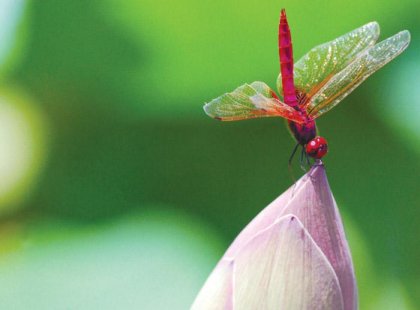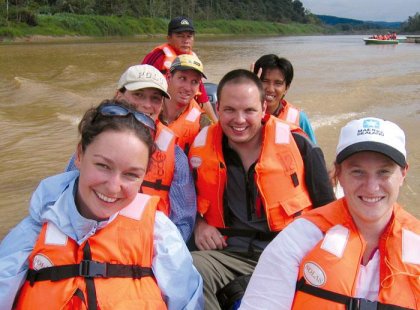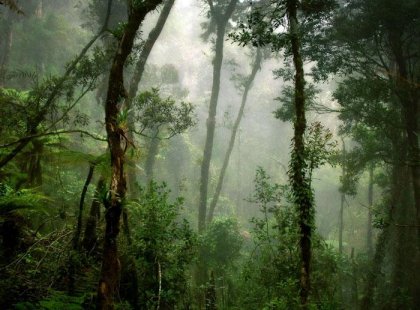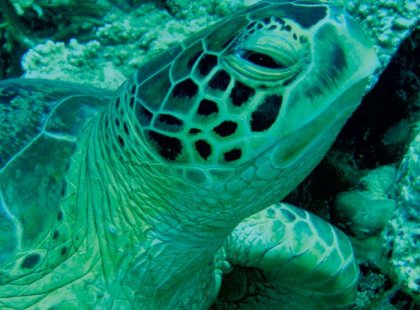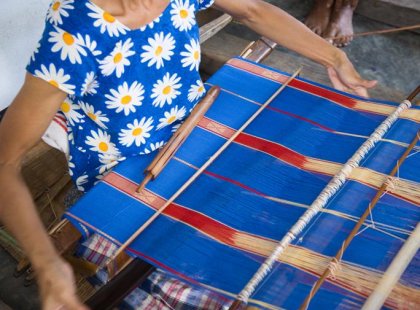Best of Borneo
21 days
from Kampong Bukit Kuching to Hilton Kota Kinabalu
From
$ 4500
Duration21 days
Travel through the wild untamed lands of beautiful Borneo. Imagine a place that is spiritual and wild, colourful and mysterious, and full of tantalising secrets - this is beautiful Borneo. From the steamy jungles of Mulu National Park and the secluded beaches of Turtle Island, to the graceful orangutans at Sepilok and small villages nestled in the shadow of Mt Kinabalu, Borneo is a true gem of South East Asia. Experience captivating sunsets, be welcomed on homestays, travel along scenic trails, laze on tropical beaches and see an abundance of wildlife - this is a tour to remember forever.
-
Duration: 21 daysService level: Standard
-
Starts in: Kampong Bukit KuchingPhysical Grading: Demanding
-
Ends in: Hilton Kota KinabaluAges: 15+
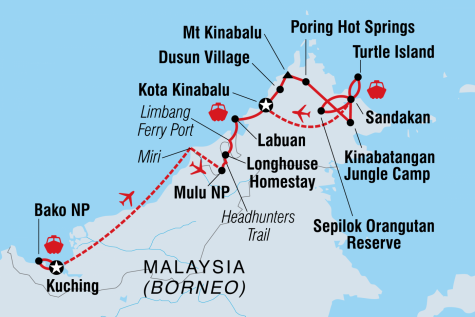
Itinerary
Day 1: Kuching
Start place: Kampong Bukit Kuching
Selamat datang! Welcome to Malaysia. Kuching, meaning 'cat' in Malay, is arguably the most pleasant city in Malaysian Borneo. It was home to the infamous White Raja of Sarawak, whose mysterious rule in this remote corner of the world sparked the imagination of many people who dreamt of becoming royalty. Your adventure begins with a welcome meeting at 6 pm, which you can find details about at the hotel’s reception. In any free time before the meeting, check out this cosmopolitan city rich in architecture, where the waterfront houses a wealth of curious shops and local vegetable, spice and fish markets. This city of skyscrapers sitting near lush green jungle is easily walked around, so maybe relish the mellow vibe and head out with your new travel companions to try some local dishes like Sarawak Laksa and Kolok mee.
Day 2: Bako National Park
Hop in a private van to the fishing village of Kampung Bako (approximately 1 hour), then a local boat up the coast to Bako National Park (approximately 20 minutes). Bako is the oldest national park in Sarawak and features rainforest, abundant wildlife, jungle streams, waterfalls, interesting plant life, secluded beaches and trekking trails. Millions of years of erosion formed a coastline of steep cliffs, rocky headlands and stretches of white, sandy bays. Waves have carved the cliffs into fantastically shaped sea arches and sea-stacks, with coloured patterns formed by iron deposits. The many jungle trails in Bako offer an insight into the island's botanical diversity. Weather permitting, you’ll take a leader-led walk to the beautiful beach at Telok Pandan Kecil (5 kilometres, approximately 3 hours return). The trail climbs through the forest before emerging onto an open plateau covered in scrub, from where curious pitcher plants can sometimes be seen. It can be a hot, but always rewarding hike. For those looking for a longer (or shorter) hike, you are free to explore as many of the 18 different trails as you like. Whatever your plan, check with the ranger for the best time to spy the quirky proboscis monkeys up in the trees. In the evening, you’ll take a night walk, a rare chance to experience the jungle in a different light.
Notes: You’ll stay in basic National Park lodgings – fan cooled, multi shared rooms. Most visitors will only come to Bako on a day trip, so after 4pm you’ll have the beach to yourselves at a prime time for wildlife spotting and spectacular sunsets. This is the best time to be at Bako National Park, and why we prefer to stay overnight. Even if the accommodation is basic, it's worth it for this experience!
Notes: You’ll stay in basic National Park lodgings – fan cooled, multi shared rooms. Most visitors will only come to Bako on a day trip, so after 4pm you’ll have the beach to yourselves at a prime time for wildlife spotting and spectacular sunsets. This is the best time to be at Bako National Park, and why we prefer to stay overnight. Even if the accommodation is basic, it's worth it for this experience!
Meals: B
Day 3: Kuching
After an optional, invigorating morning hike, farewell the jungle and return to Bako Village by boat (it may be necessary to depart the park earlier or later subject to weather conditions). Then travel by private minivan back to Kuching (approximately 1 hour). Later you will transfer to the Semenggoh Orangutan Sanctuary – a government-funded rehabilitation centre set in lush surrounds – on the way. The centre was set up to help re-introduce these wonderful creatures back into the wild after a life of domestication or having been orphaned. Head into the jungle via a walkway, where from a viewing platform you can watch and photograph the orangutans as they swing into view and eat the supplementary diet of bananas and milk that is laid out for them twice a day. Take some time to savour the special moments in these animals’ company. Human contact must be kept to a minimum and it's essential that you follow your leader's instructions. Afterwards, return to Kuching and the hotel, where you can freshen up from the heat. This evening perhaps mosey down to the riverbank and watch tambang ferries glide by, visit Sarawak Museum (one of the most popular attractions here), or head out to one of the many Chinese-influenced hawker markets for dinner and experience the range of local seafood.
Day 4: Mulu National Park
Fly to Mulu via Miri, sending your large bag on to Limbang and packing a day bag with the essentials for the next four days. When you arrive in Mulu, head into the heart of one of the most spectacular national parks in Asia – Gunung Mulu National Park. Transfer the short distance to Mulu HQ (2 kilometres) where you’ll stay for the next 2 nights. Your leader will go through some of the options for your free time here. You can take to the some of the self-guided trails around the park, or to the treetops on the world’s longest tree based canopy walkway. Or maybe simply kick back with a book and enjoy the sounds of the nearby jungle. Later there is the chance of an optional night walk to search for some weird and wonderful insects and reptiles. Tonight you’ll stay in the park headquarters, which has its own restaurant and Information Centre. Accommodation is multishare rooms with private bathroom.
Meals: B
Day 5: Mulu National Park
Today you have a free morning to explore or have a sleep in. Spend the afternoon strolling the walkways of this 180-million-year-old rainforest, and then catch the sunset flight of the bats at Deer Cave. The World Heritage-listed park has absolutely spectacular limestone geology, with enormous caves, vast cave networks, rock pinnacles, cliffs and gorges. In fact, its system of caves is the largest known in the world, formed when surface water worked its way through the rock, carving gigantic passages through the bedrock. Deer Cave has one of the single largest cave passages in the world, 2.2 kilometres long and 220 metres tall at its highest point. Before it was part of the park the cave was a well-known hunting ground for deer, who were attracted to the pools of salty water running off the heaps of guano. The guano comes from the millions of bats who call the cave home, and at dusk there’s a mass exodus as they emerge for their nightly feeding, like a seemingly endless black plume of smoke twisting across the sky. In nearby Lang cave you can appreciate the work that the water does on the limestone, sculpting waves on the ceiling, drawing stalagmites, columns and stalactites.
Meals: B
Day 6: Mulu National Park
Leave Park HQ behind and head into the jungle. Take boats for around 30 minutes downriver to the amazing Clearwater and Wind caves, which contain Asia’s longest underwater river. The Clearwater cave system runs for 107 kilometres, 75 of which have been explored. The system gets its name from the bright jungle pool at the base of the steps that lead up to the cave mouth. Wind Cave draws a cooling breeze through its lengths and features some of Gunung Mulu’s best cave formations, while Clearwater is covered in a species of bright green plant that is unique to the park and offers a real opportunity to see the water at work on the rock. Afterwards, take a longboat downriver before disembarking to hike through undisturbed jungle to Camp 5, nestled at the end of Melinau Gorge (approximately 8.5 kilometres). During dry season, the boats may need to be pushed over certain sections of the river, so it is advisable to wear strap on sandals or shoes that can get wet. At Camp 5 you will sleep in these wonderful surrounds, on mats on raised open-air platforms in a mixed gender dormitory, with shared bathroom facilities and cold water showers. Bedding is not provided so bring your own sleeping sheet and a warm layer for cool nights. Mosquito nets are available to rent for a small charge. Please be aware that at certain times of the year there can be many bees around Camp 5.
Meals: B, L, D
Day 7: Headhunters Trail/Longhouse
Today you’ll tackle the infamous Headhunters' trail. Located in an isolated area of the Bornean jungle, this 11.3 kilometre (approximately 5 hour) trail takes its name from its historical role as the route taken by warring parties between the Tutoh and Limbang rivers. The trek is through dense jungle along a well-defined, mainly flat track, although the way can be muddy during the rainy season. You'll also have to cross some streams by rope bridges, wooden walkways, logs or by getting your feet wet as you wade through. You’ll be surrounded by stunningly diverse flora, massive bird-filled trees, and the magical sounds of the forest – a hornbill flapping its wings, the cries of monkeys, and the pulse of cicadas and crickets. Then you’ll take a boat from Kuala Trekian to Kuala Medamit, a journey of around 4 hours. Depending on how much rainfall there’s been, you may be required to help push the boat over shallow parts of the river and there will be a stop at a ranger station for lunch along the way. It’s a long, challenging and rewarding day. Spend the evening at a longhouse right beside the river, where you’ll reunite with your luggage. Freshen up on arrival and enjoy dinner with the host family as well as a cultural performance once the meal is over.
Meals: B, L, D
Day 8: Labuan Island
Farewell your hosts and depart the longhouse to travel by private vehicle to Limbang (approx. one hour). From here, catch a ferry to Labuan Island (approx. 2-2.5 hours) where you’ll have a free afternoon and evening at a beach resort. Relax and recover after yesterday’s trek, chilling out with a cold drink and a good book. Maybe head to Layang-layang beach for a swim and the sunset.
Meals: B
Day 9: Kota Kinabalu
Labuan was occupied by Japanese forces during WWII and this morning you’ll have time to visit the Labuan War Memorial, where British, Australian, New Zealand, Indian, Malay and local soldiers are buried. Take some free time to wonder around town then catch the afternoon ferry to Kota Kinabalu (approx. 2.5 to 3 hours), the capital of Sabah and a modern metropolis that rebounded from multiple bombings during WWII. Kota Kinabalu has interesting museums to explore (the Sabah State Museum is a great place to immerse yourself in its backstory), markets to browse, and the surrounding beaches and islands are perfect for swimming or snorkelling. Tonight, perhaps head out to the night market for a grilled fresh seafood.
Meals: B
Day 10: Kota Kinabalu
Spend a free day in Kota Kinabalu. You could visit the Mari Mari Cultural Village, or perhaps explore the islands off Kota Kinabalu, excellent for swimming and snorkelling. There are plenty of ferries heading out and each island has a different vibe, many with small hikes and some with restaurants and resorts on them. As this is a combination trip, you may be joined today by new travellers, who will have a welcome meeting at 6 pm as you did on your first night.
Meals: B
Day 11: Dusun Village
Today you will travel by minivan to a Dusun village, nestled amid picturesque hills in the shadow of imposing Mt Kinabalu, the highest mountain between the Himalayas and New Guinea (approximately 2 hours). The Dusun people, the ethnic group of our guides on Mt Kinabalu, are wonderfully warm and friendly people, and while here you'll have the opportunity to learn about their way of life and spend a night in a village. Depending on the weather, you will then take a trek through the surrounding fruit and rubber plantations. Then your leader can point you in the direction of a local river for a great way to cool off. To ensure we do not disrupt the homestay community we split up our groups to stay in a couple of different family homes. All the homes are in waking distance from each other and you usually have a couple of group members with you at each home. Tonight you'll also get to watch a cultural performance in the village.
Meals: B, L, D
Day 12: Mt Kinabalu National Park
This morning say goodbye to your new friends from the village and travel into the unspoiled wilderness of the World Heritage-listed Kinabalu National Park (approximately 1 hour). Take some time to enjoy the surroundings and prepare for the climb. There are nature trails through the lowland tropical forest and a Botanic Garden to explore. Otherwise, just relax in the afternoon and take in the cooler clime. Before you depart, your leader will provide a safety briefing about the climb and assist with any last minute questions. Stay overnight at Kinabalu Park in a lodge with shared bathroom. Nestled among the lowland forests, this is the perfect place to chill-out before the climb.
Meals: B, D
Day 13: Mt Kinabalu National Park
Rise early the next day to begin the climb up Mt Kinabalu. It's not an easy walk, uphill all the way, and you’ll need to be prepared to tackle a trail made up of steep steps that vary considerably in size. Altitude can also affect you, regardless of your fitness level, and it will certainly slow you down a fair bit (it's important that you educate yourself about the dangers of altitude sickness and its symptoms). Ensure you have warm layers, waterproof gloves, hat, head torch, waterproof jacket and good walking shoes/boots. The top of the mountain can be deceptively cold. However, there's absolutely no rush so take your time and enjoy the pristine environment - this is an area that boasts a remarkable variety of plant life, including some 1,000 species of orchid and the extraordinary carnivorous pitcher plant. You will cover 6 kilometres on the first day (approximately 4-6 hours) and stop at a resthouse near Laban Rata (3,272 metres) for the night. The resthouses have very basic, mixed gender, multishare bunk rooms, and additional blankets can be hired from the park office. Go to bed early, so you're ready for the final climb in the morning.
Meals: B, L, D
Day 14: Mt Kinabalu - Poring Hot Springs
Rise around 2am in order to catch the sunrise at the summit of Mt Kinabalu (4,095 metres). It's difficult walking, but you'll feel a huge sense of achievement. Also, the view from the summit is incredible - the jungles of Borneo in one direction, the South China Sea in the other, making every inch of the climb worthwhile. Be warned though, the temperature can change very quickly up on the mountain, so bring clothes for all weather conditions. The climb from Laban Rata to the summit takes 2-4 hours and, due to the altitude, can be hard going even for the fit. The first section from Laban Rata is along man made steps passing through vegetation. Once clear of the treeline you will be walking up a series of wooden steps all the way to the final check point at Sayat Sayat. The window for climbing the summit trail is quite narrow so Climbers need to reach Sayat Sayat check point by 6am to continue and must listen to the instructions of the mountain guide and leader - their decision is final when it comes to safety on the mountain. After Sayat Sayat there is a rope marking the trail all the way to the summit Peak. Waterproof gloves are recommended to protect your hands from rope burn (as well as to keep them warm). After witnessing the morning sunrise, return to Laban Rata for a well-earned breakfast, and then descend the mountain (approximately 3-6 hours) to enjoy a rewarding lunch at the bottom. Once everyone is down from the mountain you will continue on to Poring Hot Springs by bus (approximately 1 hour). Tomorrow you will be able to soothe your mountain-weary limbs in pools developed by the Japanese during World War II, where warm sulphur water - believed to have healing properties for the skin - is piped into several open-air baths. Depending on the time of year it might be possible to see the Raffelsia flower nearby. Rafflesia’s are the world’s largest flower and can grow up to 1 metre in size! Tonight you will stay at a hostel located right inside the springs complex itself, with a light and airy lounge room for you to relax in. The hostel has bunk beds, multiple beds and the bathroom is shared, there are no double beds.
Meals: B, L
Day 15: Poring Hot Springs
Poring Hot Springs is an ideal place to kick back for a day to recuperate after the Mountain climb. There are a number of optional activities from which to choose. There are graded paths leading through rich lowland forest to mountain rivers, waterfalls and bat caves - with birds and other wildlife often seen along the trail. A walkway in the tree canopy provides magnificent views or there's a visit the enchanting butterfly farm. You can choose to trek to the lovely Laganan Falls or just laze about in the hot and cold pools.
Day 16: Kinabatangan River
Today, journey by private bus into the steamy rainforest to Bilit, a small village on the banks of the Kinabatangan River (approximately 5 hours). Take a short boat tide to the comfortable jungle lodge where you’ll spend the night. The lodge is located directly on the river and is a good place to spot wildlife. In the early evening as the sun sets, head out by motorised boat in search of wildlife such as macaques, Orangutan, proboscis monkeys and, if you’re lucky, spot some pygmy elephants. In the evening take a night walk in search of the western tarsier. Rubber boots and leech socks are available to hire. The lodge tonight is comfortable with private bathrooms.
Meals: L, D
Day 17: Sandakan
Today take an early morning cruise in search of wildlife. After breakfast, say goodbye to the Jungle Lodge and hit the road in a private mini van to the coastal city of Sandakan (approximately 3 hours). Along the way there’s the option to stop at the Gomantong caves (additional entrance fee). The caves are renowned for their valuable swiftlet nests, which are edible and harvested for bird's nest soup. Birds' nest collection is an ancient tradition, but nowadays locals must have licenses to climb to the roof of the caves and collect the nests, and penalties are imposed on unlicensed collectors. The nests are particularly prized in Chinese culture due to their rarity, and supposedly high nutritional value and exquisite flavour. This stop is also a great chance to spot orangutans swinging among the trees. Arrive in the busy city of Sandakan and see the strong Cantonese influence, evident in the lively harbourside market, the many Chinese temples and the local cuisine. Here there is free time to catch up on laundry and banking as well as to explore the city.
Meals: B
Day 18: Turtle Island
This morning, leave your large bags at the hotel and walk 15 minutes to a nearby jetty. Travel by speedboat, past small fishing villages and bamboo fish traps, to Turtle Island Marine Park (approximately 1 hour), where green turtles come ashore to lay their eggs every night of the year. In the afternoon, there's time for swimming, snorkelling or some quality time lazing about on the beach of this tropical island. Snorkelling gear is available for hire. In the evening, be touched by the sight of giant green turtles coming ashore to lay their eggs under the moonlight, and watch the researchers as they release protected hatchlings and guide them in their frantic dash to the ocean. It's a moving experience that makes you think more than twice about trying illegally traded turtle egg delicacies. Beware that this is a very delicate environment and you must follow instructions from your leader and the local rangers to ensure minimal impact on the turtles. You will spend the night on the island.
Meals: B, L, D
Day 19: Sepilok
After breakfast, return to the mainland (approximately 1 hours), collect your bags, and continue by minibus to a guesthouse located near the Sepilok Orangutan Rehabilitation Centre (approximately 45 minutes). The centre was set up to help re-introduce these wonderful creatures back into the wild after a life of domestication or having been orphaned. From the viewing platform, you can watch and photograph these charming creatures as they swing into view and eat the supplementary diet of bananas and milk that is laid out for them twice a day. Human contact must be kept to a minimum and it's essential that you follow the instructions of the park, as directed by your leader. Also included is a new nursery where you can view young orangutans as they learn how to climb on a specially constructed jungle gym. The viewing area is behind one-way glass so as to not disturb the animals. To see more of Borneo’s creatures there’s the option to visit the newly opened Bornean Sun Bear Conservation Center. Here rescued Sun Bears that have spent many years mistreated and locked away in cages are cared for, with hopes of rehabilitation and reintroduction into the wild. There’s also the Labuk Bay Proboscis Monkey Sanctuary where you can watch up close the amazing bachelor proboscis lazing and feeding - an experience that can only be found in Borneo. A five minutes walk from your guesthouse is the Rainforest Discovery Centre, which also has a 147-metre long, 28-metre high canopy walkway with spectacular views of rainforest giants. Your guesthouse is located about 10 minutes walk from the rehabilitation centre.
Meals: B
Day 20: Kota Kinabalu
In the morning get some insight into the city's past at the emotive War Memorial, built on the site of a Japanese POW camp. This site also marks the starting point of the tragic Sandakan Death Marches, on which 2,400 POWs were forced to walk through the jungles of Borneo. By the end of the march, only 6 Australians survived, and only because they had escaped. We then transfer to Sandakan airport and fly to Kota Kinabalu (approximately 1 hour). The flight usually gets back in the afternoon, so the rest of the day is free for your own activities. Do some last minute shopping at the large shopping centres or take a wander down to the night market to pick up something more local. You’ll end this colourful Sabah Adventure with an optional final group meal.
Meals: B
Day 21: Kota Kinabalu
Your Sabah adventure comes to an end today. There are no activities planned and you are able to depart the accommodation at any time. If you are staying in Kota Kinabalu longer, then there are some additional activities that your leader can assist with booking. It’s best to pre book these activities with your leader on Day 1. There’s a scuba dive trip from Manukan Island to see the wonderful underwater world of Borneo, or an optional fun, interactive and educational visit to Mari Mari Cultural Village to see how indigenous ethnic groups of Borneo used to live.
Please also remember Most Scuba Diving companies would recommend you don't fly for at least 24 hours after your last scuba dive.
Please also remember Most Scuba Diving companies would recommend you don't fly for at least 24 hours after your last scuba dive.
End place: Hilton Kota Kinabalu
Meals: B
Inclusions
Included
- Bako National Park
- Kuching - Semengohh Orangutan Sanctuary
- Mulu National Park
- Mulu NP - Deer & Lang Caves
- Mulu NP - Wind & Clearwater Caves
- Mulu NP - Guided trek along Headhunters' Trails
- Mulu NP - Longboat ride along the Melinau & Terikan Rivers
- Dusun Village - Guided village walk
- Dusun Village - Cultural performance
- Mt Kinabalu climb
- Kinabatangan River - Night jungle walk
- Kinabatangan River - Sunset wildlife boat trip
- Kinabatangan River - Dawn wildlife cruise
- Turtle Island - National Park
- Sepilok - Sepilok Orangutan Rehabilitation Centre
- Sandakan - War Memorial
-
Transport
4x4, Speed boat, Private Mini van, Ferry, Longtail boat, Plane, Taxi -
Accommodation
Hotel (7 nights), Dormitory/multi share (7 nights), Homestay (2 nights), Chalet (3 nights), Lodge (1 night)


